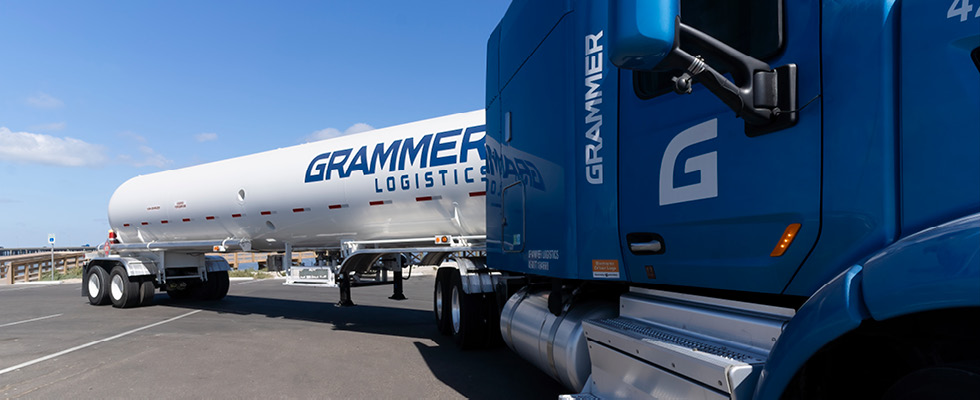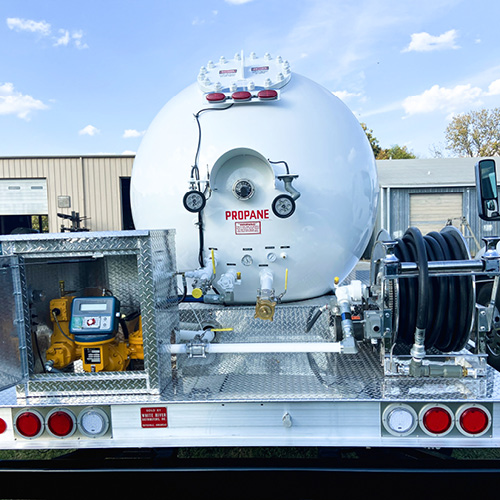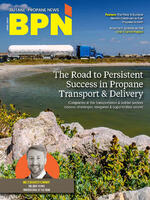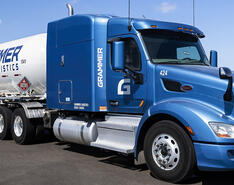
Without bobtails and transport vehicles, propane would quite literally never get anywhere — seems like a simple concept, right? But so much thought, preparation, and attention to detail and safety goes into the transport and delivery of propane all over the country. Behind these processes are the design and manufacturing innovations that make it all possible.
In this year’s Propane Transport & Delivery special section, we’re covering both the bobtail side and the transport and logistics side. Ahead, you’ll hear about bobtails from Joe Hicks, sales manager for Lux Industries; Tim Schweppe, general manager — propane division for Arrow Tank & Engineering Co.; Chris Mace, salesman for White River Distributors; and Westmor Industries' Jason Soulon, regional sales manager, Brady Griffith, regional sales manager and Makenna Hufford, marketing coordinator. After that, we’ll hear from the transport side with Henry S. Papiano, president of C Three Logistics, and Patrick Maher, chief commercial officer of Grammer Logistics. Both sections will cover product updates marketers should know about and the headwinds the industry is currently facing or seeing on the horizon
Bobtails
Are there recent bobtail design innovations your team has integrated or is looking to integrate in the near future?
Hicks: Piping. Our design eliminates vertical piping and reduces the number of flanges needed. By eliminating vertical piping and flanges, it reduces the weight, flow restrictions and maintenance.
Schweppe: Yes! We recently introduced a new deck and fender design on our bobtails. These are the major changes with the main focus being better corrosion resistance, additional truck frame space for components, and reduced weight.
- Better paint coverage: The assembly is bolted after the vessel is painted, which improves better coverage in areas that need it most.
- Shorter fenders allow more available frame space to mount toolboxes, heat exchangers, hydraulic reservoirs, tire chains, tank evacuation access, etc.
- 2B finish stainless steel deck provides a higher level of polish, which means more protection from stains and corrosion resistance.
- Improved protection from undercarriage: Precision fitted stainless steel rear filler panel protects rear head from rocks, gravel, road debris and overall deck cleanliness.
- Arrow’s Deckline skirting identity retained: Aesthetically engineered to maintain the sleek design characteristics of the original Deckline.
Westmor: At Westmor, we are committed to helping you find a propane delivery truck that meets the exact needs of your driver and operation. Much of our innovation efforts stem from ongoing conversations with drivers who use our equipment every day — their feedback is one of our most valuable tools for innovation.
One of our most widely adopted innovations is our Ergoload Deck, which is selected by approximately 75% of our Blueline bobtail customers. By lowering the spray-fill and vapor-return lines roughly 20 inches compared to traditional configurations, we’ve made loading and unloading more ergonomic. Drivers can keep heavy hoses at waist height, eliminating the need to lift them over their shoulders.
Our Pathway Delivery System features a swiveling hose reel that allows drivers to choose the path that works best for their propane delivery while providing a safe and ergonomic driver experience. It’s as simple as turning the reel to the angle that works best, locking the reel into place, and pulling the hose in the direction of the tank you’re delivering to.
Westmor’s Electrical Center brings all switches and electrical components into one central location, providing enhanced accessibility and flexibility to expand or add features in the future. This design also streamlines maintenance and troubleshooting, making diagnosing and repair quicker and easier.
Additional innovations include:
- Dual Hose Reels that offer greater delivery flexibility by supporting multiple flow rates for your mix of customers and types of deliveries.
- Back-up Camera Wash System that helps drivers keep a clear view without leaving the cab. The camera is mounted above the rear light bar and can easily get covered in dust or grime. With the push of a switch in the cab, water sprays to clean the lens, followed by air to dry it.
- The NextDoor Meter Cover makes accessing meter controls on center mount meters more efficient and ergonomic. Drivers can easily reach the necessary controls without having to lift a heavy door to print a ticket, streamlining the delivery process and improving driver satisfaction.
- The EasyReach Printer System minimizes the need for drivers to climb in and out of the cab. Mounted on slides, the printer easily extends across the cab to bring it within reach of the driver, allowing access from the ground, mitigating the need for the driver to crawl up into the cab.
How has your company navigated ongoing changes in tariffs?
Hicks: Purchasing additional inventory items for the near future is not affected by tariffs. [We are] working closely with vendors, giving them future forecasts of equipment we need so we will have access to that equipment.
Schweppe: Our team did a great job forecasting our needs coming into 2025. At this point, we are in a comfortable position where we own much of our major inventory at pre-tariff pricing. We have an open line of communication with our network of vendors from which we purchase our chassis and other components. It is imperative we stay vigilant with changes and communicate to our customers so there are no surprises.
Mace: Our company has received notifications from 90% of our vendors that prices will be increasing 5%-25%. We are holding off as long as possible, but eventually we will be forced to pass that increased cost along to our customers.
Westmor: We have experienced several price increases throughout the early part of this year, largely due to the current tariff climate and overall market uncertainty. Unlike previous disruptions, supply chains have remained mostly intact, which has presented a different set of challenges in managing cost impacts on our products. We’ve been able to leverage the strong supplier relationships developed during the COVID years, albeit in a slightly different way. This has included shifting to certain domestic products that are less affected by tariffs, as well as relying on long-standing partnerships to mitigate costs. We've implemented strategies such as placing blanket orders early in the year and utilizing pre-orders ahead of anticipated price increases, allowing us to better navigate the effects of high tariff rates.

How does your team plan around delays in manufacturing?
Hicks: Keeping stock inventory and having a couple of vendors we purchase from allows us the ability to reduce delays as much as possible. In the case delays happen, we lean on vendors to inform us in sufficient time so we can inform the customer to plan accordingly.
Schweppe: We started placing orders to our vendors at higher levels and much further in advance since the first round of tariffs in 2018 in an effort to avoid manufacturing delays and deliver on time. While this has a significant impact on cash, it is a necessity nowadays to meet customer expectations.
Mace: We are blessed at White River Distributors to have an extremely experienced team that has navigated material shortages. This has allowed us to stay on schedule for the most part.
Westmor: From a manufacturer’s standpoint, one of the most challenging aspects of the supply chain crisis is the frequency and variation of material delays. During the COVID years, when supply chains were more fractured due to production shutdowns, we focused heavily on diversifying our supply chain networks. This allowed us to navigate part shortages and minimize production downtime. With part delays and lead time changes, we are also evaluating our schedule daily and attempting to keep our products moving through production as efficiently as possible. Although the supply chain has straightened itself out into a new normal, we have adjusted our inventory levels, which ties up dollars that could be used on other items, and potentially holding inventory that will change in price due to tariffs and other potential price increases or decreases.
Have you seen any effects from inflation? If so, how have previous strategies helped you navigate those challenges?
Hicks: Costs have risen between 3% and 6%. Having a close relationship with vendors, we are able to get information about when prices might rise to give customers time to adjust.
Schweppe: This has been ongoing since 2018. Unfortunately, very few suppliers adjust prices when the markets drop to lower levels.
Mace: There has been a significant price increase due to inflation and rising raw material costs. To keep our prices competitive, we have stocked up on inventory in hopes inflation will subside and costs will move back toward normal.
What trends are you seeing these days in the bobtail driver workforce?
Hicks: Talking with propane business owners, this seems to be a challenge to get new drivers. Some of the causes are due to the requirements to get certified.
Schweppe: Fortunately, we are seeing improvement in the number of applicants and skill levels.
Mace: We have many customers who are struggling with CDL/hazmat drivers. Because of this, the drivers have been more involved in the ordering process, making the trucks even more user-friendly for those drivers.
Westmor: Labor shortages have been a challenge in recent years, especially in production and welding roles, but we are seeing gradual improvement. There has been an encouraging uptick in hiring overall, including increased interest from high school students exploring trade careers. Some have started part-time and transitioned into full-time roles after graduation. We continue to invest heavily in recruiting and training programs designed to attract new talent, including individuals without prior experience. Our in-house training remains focused on developing certified welders to meet ongoing customer demand. While hiring conditions are showing some improvement, roles that involve regular travel continue to present challenges. We’ve been fortunate to maintain a stable team of CDL drivers; however, the requirements for obtaining a HazMat endorsement, particularly the time commitment and associated cost, remain a significant obstacle for prospective candidates.

Have there been any positive signs regarding historic or current issues facing the bobtail industry?
Hicks: Chassis and equipment are more available, causing some vendors to have more inventory. Because of this, prices have held steady for the last two to three years and some vendors have lowered pricing to move inventory.
Schweppe: Bobtails are being produced at a higher quality than ever. Builders have embraced modern technology and processes to make this happen. In addition, most people today are aware that it takes a registered cargo tank facility to build a legal bobtail to operate on the roads. Bobtails must display a data plate for the cargo tank itself and a cargo tank motor vehicle plate that certifies the tank and assembly meet DOT MC-331 specifications. Additionally, every bobtail must have a certificate of compliance for the tank construction and for the assembly. This assures that critical items such as impact protection, piping assemblies, mounting, etc., meet MC-331 specs and where applicable have design certification calculations to back it up.
Mace: All the safety innovations that are integrated into the modern bobtails have resulted in a safer workplace for drivers, along with the general public.
Westmor: The supply chain conditions have normalized, resulting in more consistent reliability and a return to pre-pandemic lead times for new bobtail builds. Additionally, there is renewed optimism surrounding the anticipated introduction of a propane engine to the market.
Transport & Logistics
Are there recent innovations in the transport/logistics industry that your team has integrated?
Papiano: We utilize McCleod and have been very pleased with the software. It has several features, including a maintenance function that has integrated that department with our safety department. We are no longer waiting for inspections to be uploaded and checked. Once an inspection is complete the software communicates internally and lets dispatch know the trailer is safe to transport. That, coupled with the drivers uploading their paperwork at the offload site, means many of our customers have been invoiced while the driver is still on location, speeding up the load information timeline.
Maher: We continue to invest in and develop solutions to make our customers’ lives easier. Partnering with a transportation provider should be seamless and add value to your business. Being a traditional asset-based trucking company, we have expanded our services to now include managed transportation and truck brokerage. This has broadened the solutions we can provide for the NGL space, not limiting us to geography or equipment type to meet the customer’s needs. Further, we continue to develop rail-to-truck solutions in several markets, where landing products closer to the end user is key, from both a cost and efficiency perspective.
How has your company navigated ongoing changes in tariffs?
Papiano: Tire prices seem to be the ones that are going to cost the most. We were fortunate to upfit most of our equipment with tires prior to the tariffs coming out; however, I feel that the other shoe has not dropped yet on the amount of price increases that we are going to see for truck parts, fluids, etc.
Maher: As a transportation provider, we are closely watching the potential impact of tariffs on our equipment and maintenance parts. We maintain an ongoing and consistent dialogue with our long-standing vendor relationships. Our customers are also trying to navigate changes in real time. Grammer’s flexibility to meet changing demand remains key in supporting the butane and propane markets.
How does your team plan around delays in manufacturing?
Papiano: I feel that we are the best at this in the business. Our drivers are very good at relaying delays and outages back to our dispatch team, which enables them the opportunity to flex around those delays and keep the wheels moving. Many times we are working directly with the refineries and terminals to understand their capacity and working our dispatch around their issues to avoid delays.
Maher: Leveraging technology and an in-depth market knowledge of the NGL and LP gas markets is key. Our team works to understand the customer’s unique business to mitigate delays and pivot quickly. We leverage technology, starting with in-cab devices, to provide us with real-time tracking and tracing back to our central operation center. The plan is built with room for flexibility, as some delays are unavoidable.
Have you seen any effects from inflation? If so, how have previous strategies helped you navigate those challenges?
Papiano: Have not seen this yet; however, the rates are definitely going down. We are in a “post-COVID” era and rates are getting closer to pre-COVID numbers. It is difficult to navigate with insurance premiums, tariffs and wages all going up; however, we have worked hard to reduce our expenses to make up the difference.
Maher: Yes, we’ve continued to experience inflationary pressure across multiple areas of our business — particularly in labor, equipment, maintenance, insurance and technology costs. We are actively mitigating these pressures through a return-oriented approach to cost evaluation, ensuring every dollar we spend improves the quality or efficiency of our business for the benefit of our customers and employees. We are also leaning more heavily on technology to drive efficiency and reduce waste. Lastly, we are being very thoughtful about the market niches we serve best — doubling down and increasing network density where our capabilities are best aligned with our customers’ demand.
What trends are you seeing in the transport and logistics workforce?
Papiano: The key to the shortages of drivers is dispatching smarter. With our dispatch technology, we are able to reduce dead head and strategize the peaks and valleys, and by doing so, accomplish the same volume with less power units. The best hiring recruiters we have in our company are the current drivers. We strive to make the driver understand how important they are, and their word of mouth has enabled a steady flow of applications coming in.
Maher: The ability to hire certified mechanics, especially in rural areas, has been challenging. We operate the largest fleet in the industry of MC-331 pressurized tanks, which require specialized maintenance. We perform these services at our regional shop facilities located throughout the U.S. From a driver perspective, while the average age of truck drivers in the U.S. is 49 years old, it is not uncommon for fleets to be comprised of many drivers in their 50s and 60s. The longer-tenured drivers have invaluable experience and product knowledge, which takes time to replicate with younger drivers entering the workforce. Grammer’s training and in-field development is focused on equipping the drivers with the skills and knowledge needed to excel at their jobs long term.
Have there been any positive signs regarding historic or current issues facing the transport industry?
Papiano: The transportation [industry] has been impacted for common carriers dramatically, with retailers purchasing their own tractor trailers. While this is great for the retailer to have more control of their supply, it creates a void in the slow months for common carriers to keep trained, experienced drivers employed year-round. This has an adverse effect on the entire industry because when the winter finally does hit, the common carriers are the ones that respond to the demand. Not having the current driver pool able to deliver to many of these locations that only need support for a few months out of the year causes delays with deliveries and can create safety issues with not every plant being built the same way, as well as slowing the flow. When I first entered this industry over 25 years ago, it was the opposite. The common carriers were growing because the retailers were getting out of the hauling sector. With the current changes in federal regulations and the price of insurance, I feel that we will see this circle back around.
To take a look at other BPN articles exploring the ins and outs of propane transport vehicles, click here.


